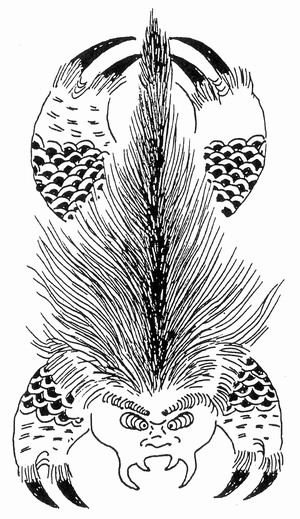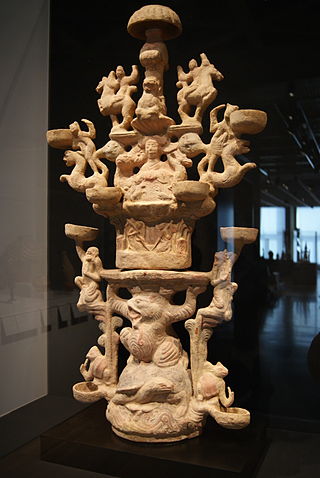Related Research Articles
Huli jing are Chinese mythological creatures usually capable of shapeshifting, who may either be benevolent or malevolent spirits. In Chinese mythology and folklore, the fox spirit takes variant forms with different meanings, powers, characteristics, and shapes, including huxian, hushen, husheng, huwang, huyao, huzu, and jiuweihu.

A nian beast is a beast in Chinese mythology. According to Chinese mythology, the nian lives under the sea or in the mountains. The Chinese character nian more usually means "year" or "new year". The earliest written sources that refer to the nian as a creature date to the early 20th century. As a result, it is unclear whether the nian creature is an authentic part of traditional folk mythology, or a part of a local oral tradition that was recorded in the early 20th century. Nian is one of the key characters in the Chinese New Year. Scholars cite it as the reason behind several practices during the celebration, such as wearing red clothing and creating noise from drums and fireworks.
Merfolks, Mercreatures, Mermen or Merpeople are legendary water-dwelling human-like beings. They are attested in folklore and mythology throughout the ages in various parts of the world.

In Japanese mythology, the raijū is a legendary creature associated with lightning and thunder, as well as the god Raijin.
Hundun is both a "legendary faceless being" in Chinese mythology and the "primordial and central chaos" in Chinese cosmogony, comparable with the world egg.

The three-leggedcrow is a mythological creature in various mythologies and arts of East Asia. It is believed to inhabit and represent the Sun.

The Classic of Mountains and Seas, also known as Shanhai jing, formerly romanized as the Shan-hai Ching, is a Chinese classic text and a compilation of mythic geography and beasts. Early versions of the text may have existed since the 4th century BCE, but the present form was not reached until the early Han dynasty. It is largely a fabulous geographical and cultural account of pre-Qin China as well as a collection of Chinese mythology. The book is divided into eighteen sections; it describes over 550 mountains and 300 channels.

A hellhound is a mythological hound that embodies a guardian or a servant of hell, the devil, or the underworld. Hellhounds occur in mythologies around the world, with the best-known examples being Cerberus from Greek mythology, Garmr from Norse mythology, the black dogs of English folklore, and the fairy hounds of Celtic mythology. Physical characteristics vary, but they are commonly black, anomalously overgrown, supernaturally strong, and often have red eyes or are accompanied by flames.
The nine-tailed fox is a mythical fox entity originating from Chinese mythology.

Nüba, also known as Ba (魃) and as Hanba (旱魃), is a Chinese drought deity. "Ba" is her proper name, with the nü being an added indication of being feminine and han meaning "drought".

The Kunlun or Kunlun Shan is a mountain or mountain range in Chinese mythology, an important symbol representing the axis mundi and divinity.

Horses are an important motif in Chinese mythology. There are many myths about horses or horse-like beings, including the pony. Chinese mythology refers to those myths found in the historical geographic area of China. This includes myths in Chinese and other languages, as transmitted by Han Chinese as well as other ethnic groups. There are various motifs of horses in Chinese mythology. In some cases the focus is on a horse or horses as the protagonist of the action, in other cases they appear in a supporting role, sometimes as the locomotive power propelling a chariot and its occupant(s). According to a cyclical Chinese calendar system, the time period of 31 January 2014 - 18 February 2015 falls under the category of the (yang) Wood Horse.
In Chinese mythology, the xiao is the name of several creatures, including the xiao "a long-armed ape" or "a four-winged bird" and shanxiao "mischievous, one-legged mountain spirit". Furthermore, some Western sources misspell and misconstrue the older romanization hsiao as "hsigo" [sic] "a flying monkey".
The Red River or Red Water is an important feature in the mythological geography of Chinese literature, including novels and poetry over a course of over two millennia from the Warring States to early Han dynasty era poetry of the Chuci onward. The Red River is one of the mythological rivers said to flow from Kunlun, a mythological land, with mountainous features. Translations into English include "Scarlet River".

The Bifang is a mythological bird, encountered in Chinese mythology. The Bifang is thought to have one leg. However, sources vary in terms of its description.

Birds in Chinese mythology and legend are of numerous types and very important in this regard. Some of them are obviously based on real birds, other ones obviously not, and some in-between. The crane is an example of a real type of bird with mythological enhancements. Cranes are linked with immortality, and may be transformed xian immortals, or ferry an immortal upon their back. The Vermilion Bird is iconic of the south. Sometimes confused with the Fenghuang, the Vermilion Bird of the south is associated with fire. The Peng was a gigantic bird phase of the gigantic Kun fish. The Jingwei is a mythical bird which tries to fill up the ocean with twigs and pebbles symbolizing indefatigable determination. The Qingniao was the messenger or servant of Xi Wangmu.
Fuzhu is a mythical beast in ancient Chinese myths and legends. It appears in the Shanhaijing.

In Chinese mythology, Heluo fish and Zi fish are fish with one head and ten bodies.
References
- ↑ Strassberg, Richard E. (5 March 2018). A Chinese Bestiary: Strange Creatures from the Guideways Through Mountains and Seas. University of California Press. ISBN 978-0-520-29851-4.
- ↑ Shizhen, Li (2 February 2021). Ben Cao Gang Mu, Volume II: Waters, Fires, Soils, Metals, Jades, Stones, Minerals, Salts. University of California Press. ISBN 978-0-520-37989-3.